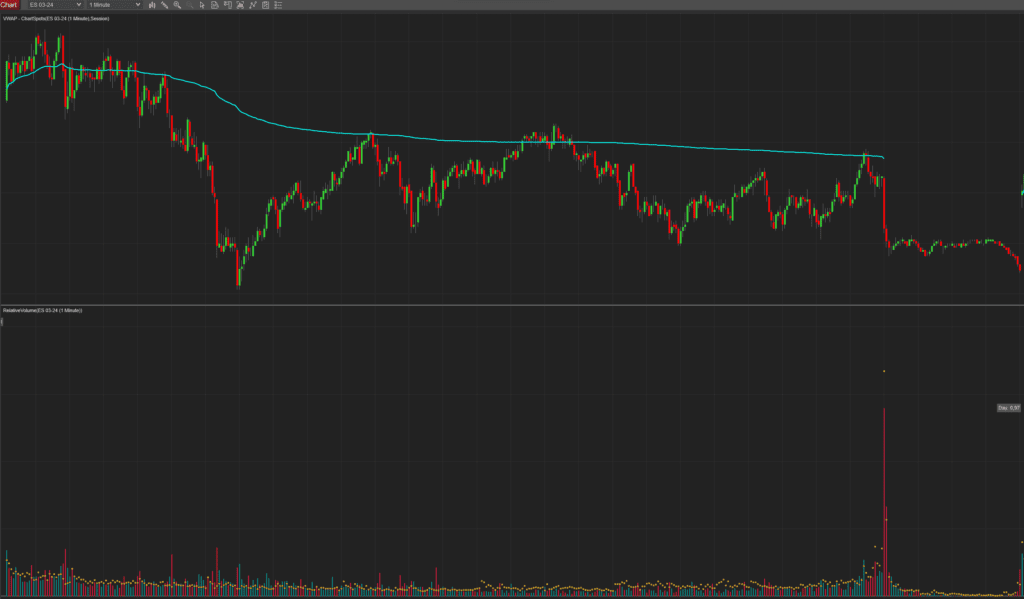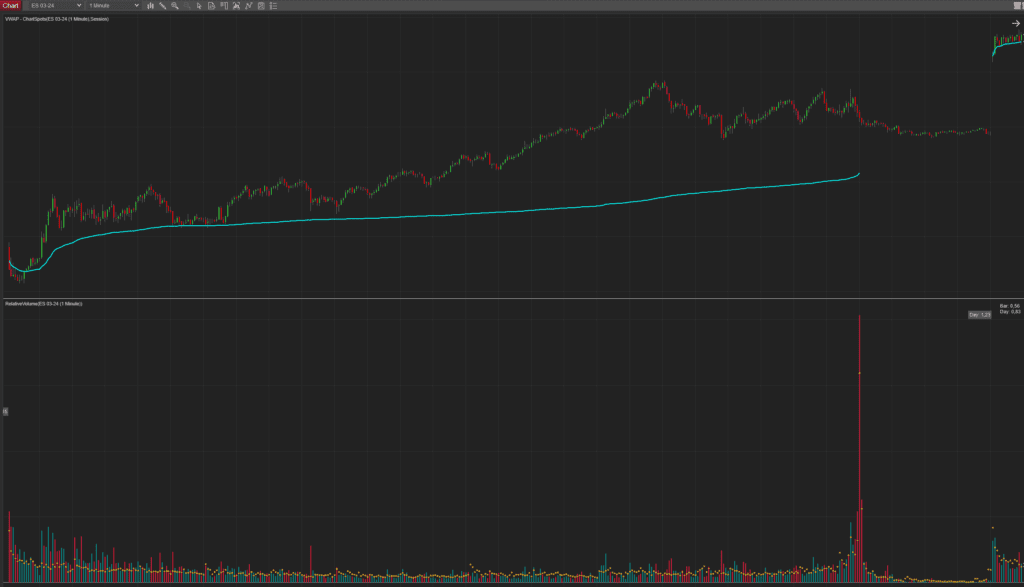
In the dynamic world of day trading, understanding the subtleties of market indicators can be the difference between success and failure. This comprehensive guide is dedicated to unveiling the power of Relative Volume (RVOL) in trading, an essential tool for traders looking to harness market movements to their advantage. Our aim is to equip you with the knowledge and tools to optimize your trading strategies through the effective use of Relative Volume. Whether you’re a novice learning the ropes or a seasoned trader seeking to refine your approach, this article is your gateway to mastering Relative Volume.
In the bustling world of day trading, where every tick of the market can herald new opportunities or signal caution, the savvy trader knows the value of every tool in their arsenal. One such tool, often the unsung hero of the trading strategy, is Relative Volume (RVOL). Let’s explore what makes Relative Volume a critical indicator for traders, whether you’re just starting out or are looking to refine your approach with more nuanced insights.

“Relative Volume helps you “feel” the market’s energy by comparing current trading volume to the usual volume for the same time of day“.
– Chart Spots
At its core, Relative Volume is not just about numbers—it’s about context. Imagine walking into a room and sensing the energy; in trading, Relative Volume helps you “feel” the market’s energy by comparing current trading volume to the usual volume for the same time of day. It’s a ratio, a way to measure if there’s more or less activity than expected. When we talk about RVOL, we’re looking at how today’s volume stacks up against past performance over a specific period. This comparison gives traders a deeper understanding of the market’s enthusiasm or lack thereof for a particular stock or asset.
Why does RVOL matter for day traders? Because in the fast-paced world of day trading, being able to quickly identify where the action is heating up can mean the difference between catching a wave or missing out. High Volume compared to the Relative Volume of that time-period indicates significant interest in a stock, often preceding price movements. It’s like having a radar for market momentum, enabling traders to spot potential entry and exit points more effectively. Whether you’re looking to jump on a breakout before it happens or find a quiet spot for a mean reversion play, RVOL provides the insights needed to make those decisions with confidence.

Now, you might wonder, “Isn’t volume enough? Why do I need to know the Relative Volume?” Here’s the thing: while volume tells you how many shares were traded, it doesn’t give you the whole picture. Consider volume as the raw data, the sheer quantity of shares changing hands. In contrast, Relative Volume is about perspective. It tells you how the current volume compares to what’s typical for that time of day or that period in the market.
Imagine you’re looking at a stock with a million shares traded in the first hour of the trading day. Impressive, right? But what if I told you that on average, this stock sees two million shares traded in the same hour? Suddenly, that “impressive” volume might not seem so noteworthy. This is where Relative Volume shines, offering a lens through which to view volume not just as a number, but as a marker of significance or deviation from the norm.
For day traders, this distinction is crucial. It’s not just about how much is being traded, but how that amount compares to the expected trading activity. Volume significantly higher than its Relative Volume can be a beacon, highlighting that the asset is attracting more attention than usual, potentially signalling a move. Conversely, volume lower than its Relative Volume might suggest caution, indicating less interest than anticipated.

“Relative Volume compares current Volume to what’s typical for that time of day “.
– Chart Spots
The Relative Volume indicator is a powerful tool that measures the current volume of trading for a specific period against the average volume for the same period over a longer timeframe. It highlights when trading activity is unusually high or low, offering clues about potential market moves. This insight is invaluable because it allows traders to gauge the strength behind price movements, distinguishing between those with significant backing and mere noise.
Calculating RVOL might sound like you need a PhD in mathematics, but it’s actually quite straightforward. Here’s a simplified version to get you started:
For instance, if the average volume for the first 30 minutes over 10 days is 100,000 shares and today’s volume for that period is 150,000 shares, the RVOL factor is 1.5. This indicates that today’s trading activity is 50% higher than the average, suggesting increased interest or activity in that asset.
In NinjaTrader 8, a popular trading platform known for its advanced analysis capabilities, you can use the Chart Spots Relative Volume indicator, making it easier for traders to implement this analysis in their strategy. This tool automatically calculates and displays RVol, freeing you from manual calculations and allowing you to focus on what matters most—making strategic trading decisions.
Integrating the RVol indicator into your NinjaTrader 8 platform enhances your trading in several ways:
Boost your trading game with ChartSpots’ Relative Volume (RVOL) indicator. Witness real-time volume insights and catch market moves early with our 2-week free trial!
Let’s explore the foundational strategies around RVOL, explore its capabilities in detecting potential crucial market movements like mean reversion and breakouts, and discuss what makes a good RVOL figure for day trading.
At its core, a Relative Volume trading strategy leverages the indicator to identify anomalies in trading volume—times when the activity is significantly higher or lower than the norm. These anomalies often precede pivotal market movements, providing a cue for traders to anticipate and react to upcoming opportunities.
A basic RVOL strategy involves:

In this example the Relative Volume Factor for the day is 0.97: meaning completely average volume. In the Price Action, we see that the price keeps reverting to the mean Volume Weighted Average Price (VWAP)

Early on in the session, we see volume consistently exceeding the Relative Volume (orange dots). The Factor for the day ends up at 1.25: meaning significantly higher volume than usual. The Price Actions shows an upward trend. The next Session opened above the prior session’s range.
A “good” RVOL figure isn’t one-size-fits-all; it’s contextual, varying across stocks and market conditions. However, there are general guidelines to help you interpret RVOL values effectively:
Incorporating RVOL into your day trading strategy offers a distinct edge, allowing you to navigate the markets with an informed perspective. This strategic edge is about more than just following numbers; it’s about interpreting what they signify in the broader market narrative and how they align with your trading philosophy and strategy.
Traders often find themselves asking, “How much historical data do I really need as a basis for the RVOL calculation?” When it comes to leveraging Relative Volume (RVOL) for your trading strategy, the answer isn’t just about quantity but about the quality and relevance of the data you choose to analyze. Let’s explore the critical role historical data plays in RVOL analysis and how to determine the right amount to enhance your trading effectiveness.
Historical data serves as the bedrock of RVOL calculations, providing the context necessary to interpret current volume activity. Think of it as the backstory to a novel; without understanding the characters’ pasts, their actions in the present may seem random or confusing. Similarly, without a backdrop of historical volume data, today’s volume spikes or drops could lead to misinterpretation.
Historical data allows traders to:
Finding the sweet spot for the amount of historical data requires a balance between comprehensiveness and relevance. Too little data might not provide a reliable average, while too much could dilute recent trends with outdated information. Here’s how to strike that balance:
In essence, the “right” amount of historical data varies among traders and their strategies, but the goal remains the same: to leverage RVOL in a way that enhances your understanding of market movements and improves your trading decisions. By thoughtfully selecting your historical data window, you ensure that your RVOL analysis is both relevant and actionable, giving you a clearer picture of the market and a strategic edge in your trading endeavours.
As day traders, we’re in a constant quest to refine our strategies and edge out the competition. Incorporating Relative Volume (RVOL) into your trading toolkit can be a game-changer, offering insights that go beyond mere price movements to reveal the momentum behind them. Let’s dive into the best practices for integrating RVOL into your day trading strategy and share some insider tips and tricks for maximizing its effectiveness.
Integrating Relative Volume into your day trading strategy isn’t just about adding another tool to your arsenal; it’s about deepening your understanding of market dynamics and enhancing your decision-making process. By following these best practices and tips, you’re not just trading; you’re trading with insight, precision, and an edge that can significantly increase your chances of success in the fast-paced world of trading.
As we wrap up our comprehensive journey through the world of Relative Volume (RVOL) in day trading, it’s clear that this dynamic indicator is more than just a metric—it’s a lens through which savvy traders can view the market, revealing the underlying momentum and sentiment driving price movements. Let’s distil our exploration into key takeaways and encourage you to integrate RVOL into your trading strategy, unlocking new levels of market success.
As you stand at the threshold of integrating or deepening your use of Relative Volume in your day trading endeavours, consider this not just an invitation but a call to action. RVOL is more than a tool; it’s a pathway to elevating your trading strategy, offering a clearer understanding of market dynamics and empowering you with the confidence to make swift, informed decisions.
We encourage you to delve into RVOL analysis, experiment with its applications, and witness first-hand how it can transform your approach to day trading. Whether you’re a newcomer seeking to establish a solid foundation or a seasoned trader aiming to refine your strategies, RVOL presents an opportunity to achieve greater market success.
Remember, the journey to becoming a proficient day trader is ongoing, marked by continuous learning, adaptation, and growth. Embrace RVOL as a critical component of your trading arsenal, and let it guide you to new heights of trading mastery and market success. Here’s to your trading journey—may it be informed, strategic, and, most importantly, profitable.

Kevin is the founder of Chart Spots and has been active in the financial markets since 2016. With a background in IT and business consulting that dates back to 2006, he combines technical expertise with real-world trading experience. Kevin founded ChartSpots in 2017 to provide data-driven tools and insights that empower traders at all levels.
Read our Disclaimer , Terms and Conditions and Privacy and Cookie Policy.
CFTC RULE 4.41 – HYPOTHETICAL OR SIMULATED PERFORMANCE RESULTS HAVE CERTAIN LIMITATIONS. UNLIKE AN ACTUAL PERFORMANCE RECORD, SIMULATED RESULTS DO NOT REPRESENT ACTUAL TRADING. ALSO, SINCE THE TRADES HAVE NOT BEEN EXECUTED, THE RESULTS MAY HAVE UNDER-OR-OVER COMPENSATED FOR THE IMPACT, IF ANY, OF CERTAIN MARKET FACTORS, SUCH AS LACK OF LIQUIDITY. SIMULATED TRADING PROGRAMS IN GENERAL ARE ALSO SUBJECT TO THE FACT THAT THEY ARE DESIGNED WITH THE BENEFIT OF HINDSIGHT. NO REPRESENTATION IS BEING MADE THAT ANY ACCOUNT WILL OR IS LIKELY TO ACHIEVE PROFIT OR LOSSES SIMILAR TO THOSE SHOWN.
GOVERNMENT REGULATIONS REQUIRE DISCLOSURE OF THE FACT THAT WHILE THE TRADING IDEAS AND TRADING METHODS SHOWN ON THIS WEBSITE MAY HAVE WORKED IN THE PAST; BUT PAST RESULTS ARE NOT NECESSARILY INDICATIVE OF FUTURE RESULTS. WHILE THERE IS A POTENTIAL FOR PROFITS THERE IS ALSO A HUGE RISK OF LOSS. A LOSS INCURRED IN CONNECTION WITH TRADING FUTURES CONTRACTS, STOCKS, OPTIONS OR FOREX CAN BE SIGNIFICANT. YOU SHOULD THEREFORE CAREFULLY CONSIDER WHETHER SUCH TRADING IS SUITABLE FOR YOU IN LIGHT OF YOUR FINANCIAL CONDITION SINCE ALL SPECULATIVE TRADING IS INHERENTLY RISKY AND SHOULD ONLY BE UNDERTAKEN BY INDIVIDUALS WITH ADEQUATE RISK CAPITAL.
RISK DISCLOSURE: FUTURES AND FOREX TRADING CONTAINS SUBSTANTIAL RISK AND IS NOT FOR EVERY INVESTOR. AN INVESTOR COULD POTENTIALLY LOSE ALL OR MORE THAN THE INITIAL INVESTMENT. RISK CAPITAL IS MONEY THAT CAN BE LOST WITHOUT JEOPARDIZING ONES’ FINANCIAL SECURITY OR LIFE STYLE. ONLY RISK CAPITAL SHOULD BE USED FOR TRADING AND ONLY THOSE WITH SUFFICIENT RISK CAPITAL SHOULD CONSIDER TRADING. PAST PERFORMANCE IS NOT NECESSARILY INDICATIVE OF FUTURE RESULTS
TESTIMONIAL DISCLAIMER: TESTIMONIALS APPEARING ON CHARTSPOTS.COM MAY NOT BE REPRESENTATIVE OF THE EXPERIENCE OF OTHER CLIENTS OR CUSTOMERS AND IS NOT A GUARANTEE OF FUTURE PERFORMANCE OR SUCCESS
ALL INFORMATION ON THIS WEBSITE IS PROVIDED FOR EDUCATIONAL PURPOSES ONLY AND NOT AN OFFER OR A RECOMMENDATION TO TRADE FUTURES CONTRACTS, STOCKS, OPTIONS OR FOREX.